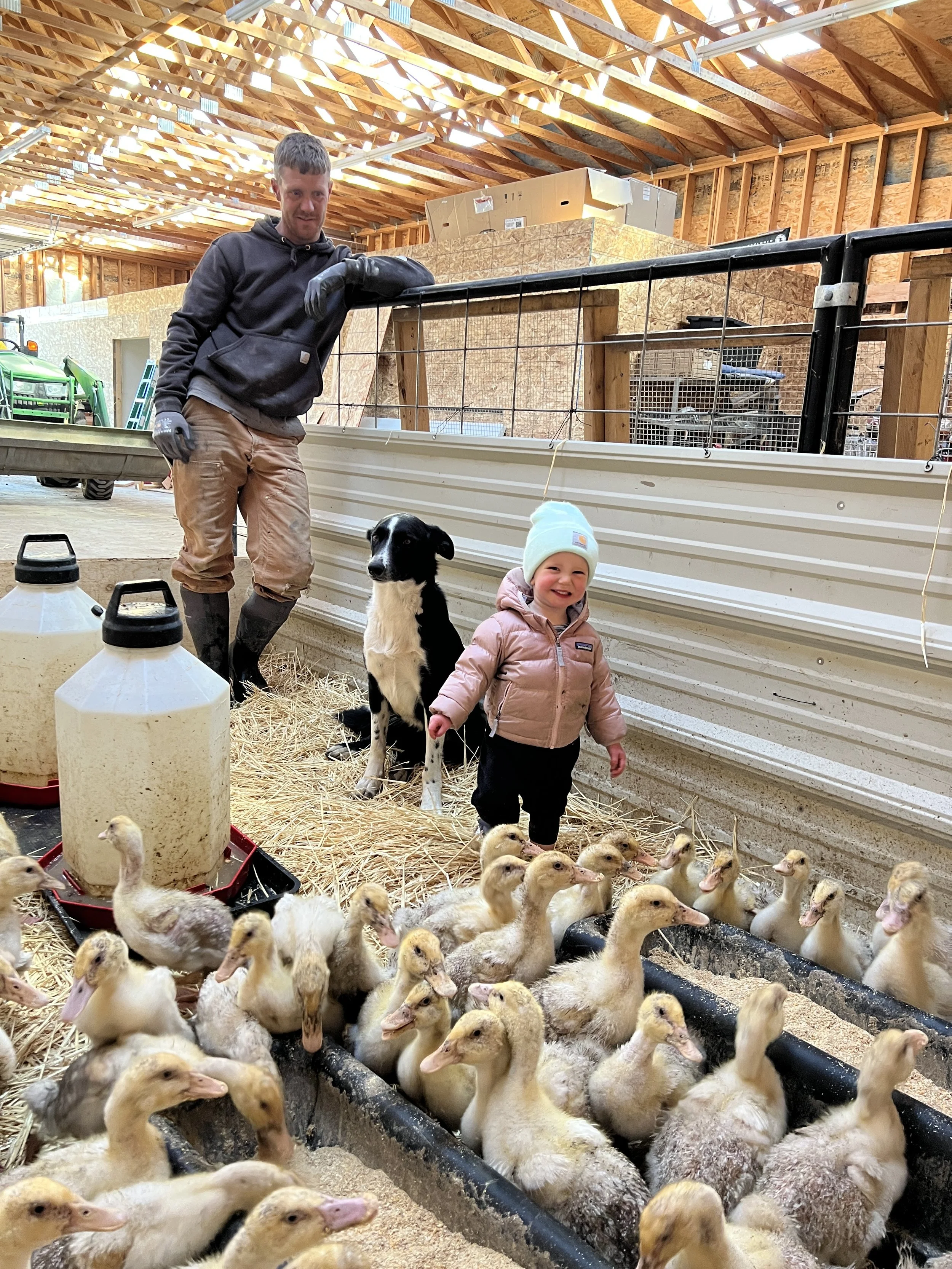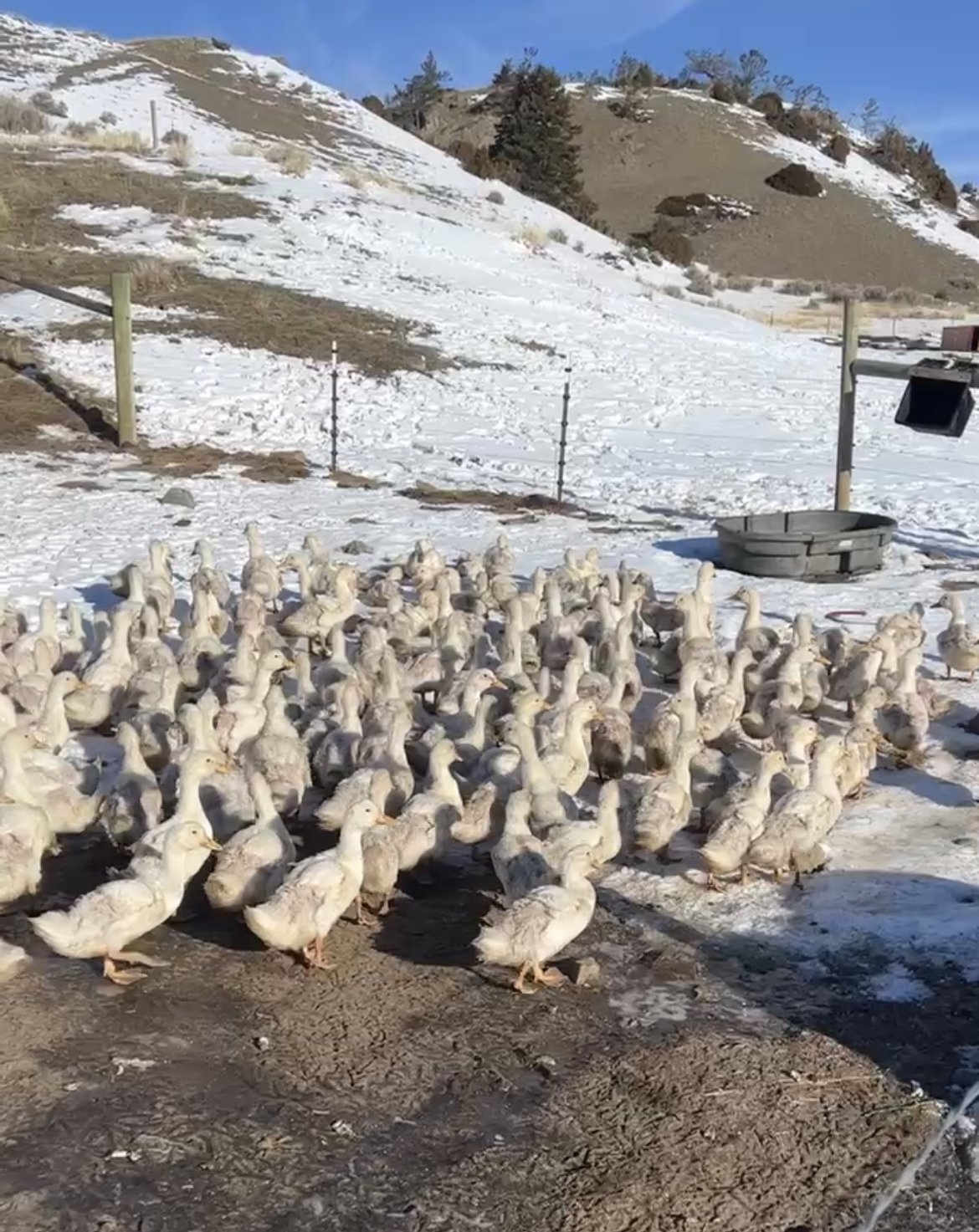This last week, we processed 292 Pekin ducks here on the farm. The ducks arrived at the end of February as day old ducklings from a hatchery in California. Our long, long, never ending (still going) winter complicated our plans for the ducks a bit, but they still did great. Over the course of 8 weeks, we only lost 11 out of 303, which is amazing for any poultry that is shipped in the mail at 1 day old and raised free range.
Last year, we raised 125 ducks at the end of the summer. We had a huge learning curve with processing those ducks, and decided to do another batch before our meat chicken season really takes off this year. After having now raised ducks in late summer and early spring, a clear winner for time of year has emerged: late summer. While the ducks did just fine this spring, it is so much easier to do them in the summer. And while we had a heck of a time with processing them last year, this year it went much smoother. So we are continuing to learn and hope to raise more ducks in the future!
I’ve been thinking a lot this week about ducks vs. chickens, and what we’ve learned about ducks so far, and thought it would be neat to do a sort of “pros and cons” discussion of each.
First, the ducklings are hands down hardier and easier to raise than chicks. Their mortality is much lower in the early days and they seem to handle shipping much better than chicks. Last summer, we only had supplemental heat on the ducklings for 1 week, and this spring it was about 2 weeks. At that point, the ducks are perfectly fine to regulate their own body temperatures. Our current chicks are about 6 weeks old and we are just weaning them off supplemental heat now! In the summer, chicks sometimes only need heat for a few weeks, but it is very weather dependent. And while the ducklings need more and deeper water than the chicks, we haven’t found this to be overly problematic or messy.
Second, ducks flock and herd, but chickens don’t. This makes moving the ducks (whether putting them away at night or loading them onto the trailer to go out to pasture) a piece of cake! Chickens scatter and go in a hundred directions, but ducks file neatly and easily wherever you’re trying to move them. It makes things SO much easier.
Third, the ducks grow much faster. Even on a corn and soy free feed (a very similar feed to what our chickens eat), the ducks are ready to butcher in 8 weeks. We raise our chickens to about 13-14 weeks. This doesn’t necessarily mean the ducks eat less though; they eat a lot in those 8 weeks! And, ducklings are about 3x more expensive than chicks, and our duck feed is more expensive than our chicken feed.
But, while the ducks seem generally easier to raise, they are not easier to process. The first reason is that you can only process ducks in certain “windows” relating to their molts. Ducks molt a number of times in their lives, notably at 8 and 12 weeks. When they molt, they lose their feathers and regrow new ones, and the new feathers are called “pin feathers.” The pin feathers first grow as short shafts before the rest of the feather comes out. If you try to process ducks after they molt and before the new feathers are fully grown, they will not pluck well and you’ll end up with lots and lots of feather shafts left behind. This is the lesson we learned the hard way last year. So this year, we processed them at 8 weeks and had NO pin feathers! Whereas last year we were only able to do 30 ducks per day, this year we did 150 per day! So that was MUCH better.
However, regardless of getting the timing right, ducks are still more laborious to process. Being waterfowl, they simply don’t pluck as well and a good number of them require some additional hand plucking (or waxing) after they come out of the plucker. Second, they are more difficult to eviscerate because their body cavity is smaller and narrower, their organs are generally more difficult to get out, and their skin is thicker.
So, the pros are that ducks are easier and more fun to raise. The cons are the processing is harder and more time consuming, and harder to get “perfect”. We read a blog from another farmer who raises thousands of ducks per year, and he said he finally had to change his idea of what a “sellable” duck is — meaning ducks do not pluck perfectly and may require some additional plucking by the consumer prior to cooking (or not! most feathers will just burn off). The farmer (or processor) simply can’t take the time to remove every single feather from every single duck. This was a nice reality check for us and has allowed us to give ourselves more grace throughout the process.
We hope you’ll try one (or more!) of these ducks! Below, you’ll find the information we sent home with our 2022 ducks, as well as some recipes.
Black dog farm duck information
Thanks for purchasing whole ducks from Black Dog Farm! These are Pekin meat ducks and were our test batch to gauge interest for duck in the community. Some important notes about your ducks:
Waterfowl are much harder to defeather than chickens are, so you may notice some down feathers (small, yellow, soft) and/or a few pin feathers (clear or white, hard, individual) on your ducks. If you are planning to eat the skin (you should!) you may need to spend just a few minutes removing those last feathers. The down feathers come off well by using your thumb to rub them off. The pin feathers come out with a good set of fingernails or a pair of needle nose pliers. We spent a lot of time defeathering the ducks, but just like with fish bones, sometimes there are a few left over.
Like all of our animals, these ducks were raised outside on pasture and lived real lives being real ducks. As a result, you may notice some imperfections, mostly minor skin imperfections like scratches or tiny bruises. These won’t affect the quality or taste of your ducks and are evidence of a good life lived.
We know that you all are purchasing our poultry because of the way we are raising it and because we are a small farm, using human labor (our hands) to raise and process our poultry. This means our finished product does not look like it was raised in a controlled environment and processed perfectly with state-of-the-art technology, and that we do not discard products that have minor imperfections. While I was researching and troubleshooting some processing difficulties we were having, I stumbled across an article written by another small farmer raising ducks for retail sale, which was helpful because the vast majority of information found online about processing ducks pertains to people raising small numbers of ducks for their own tables. After the last week of processing these ducks, a much slower process than we anticipated, and years of raising pastured poultry, the following quote from the article struck a chord with me:
“With this, though, we have also gradually adjusted our expectations of what a salable, tableready duck looks like. No longer do we have in mind a squeaky clean, sanitized bird that looks as little as possible as though it used to be living. Our ducks are the culmination of a human-scale, artisanal approach to poultry raising and processing, and if there remain a few tufts of down or stubs of feather shafts on each carcass, so much the better. Rather than a detriment to the process, we consider them the evidence that we are doing things the right way.”
We hope the above gives you some insight into these beautiful ducks you are about to enjoy!
Recipes & Notes On Cooking Whole Duck
How To Roast A Whole Duck + Duck a l’Orange Recipe
One of my favorite resources for not only recipes but also the “how and why” of cooking an ingredient is the website Serious Eats. It offers tried and tested techniques and explains why those techniques work for a huge range of food. Here are some of their recommendations for how to roast a whole duck:
Unlike chicken that has delicate white meat that can easily get dry, duck is just as delicious served well-done as the commonly recommended medium rare.
Duck handles high heat REALLY well for 2 reasons: all of the meat is on the darker side, which means it is richer and oilier, allowing it to better withstand the drying effects of high temperature; and the fatty skin insulates the meat and bathes it in rendered fat as it cooks.
Cook & eat the duck with the skin.
DO NOT under roast your duck for fears of overcooking it. If the skin is great, the duck will be too.
Consider a boiling-water blanch prior to roasting (see the link below)
Consider pricking the skin with a sharp knife or skewer prior to cooking to help the fat render under the skin.
DO NOT start the duck at a lower temperature and then raise it; the skin and fat don’t brown and render well.
Recipe & Article From serious Easts Duck a l'Orange
Smoked Duck
Another great way to cook a whole duck is smoking it. Here is a great article and recipe for How To Smoke Duck: www.theonlinegrill.com/smoked-duck
Even if you don’t have a smoker or don’t want to smoke your duck, this article is worth a read because it has some good information about cooking duck in general.
Cook at 225F for about 4 hours to reach an internal temperature of 165F
Pierce the skin prior to cooking
Use a dry brine of kosher salt and allow to rest for at least 8 hours (or overnight) before smoking.
Baste your duck while it is smoking.
If you are having trouble achieving the internal temperature of 165F, cover with aluminum foil for the last hour.


















